DeKo DKAG20BL01 User manual

INSTRUCTION MANUAL
20V BRUSHLESS ANGLE GRINDER
1
DEKO TOOLS CO., LIMITED
www.dekotools.com Made in China
IMPORTANT:
Read this instruction manual before operating this product.
Keep the instruction manual for future reference.
Model No.:DKAG20BL01
V2109

2
General Power Tool Safety Warnings
1) Work area safety
a) Keep work area clean and well lit. Cluttered or dark areas invite accidents.
b) Do not operate power tools in explosive atmospheres, such as in the presence of flammable
liquids, gases or dust. Power tools create sparks which may ignite the dust or fumes.
c) Keep children and bystanders away while operating a power tool. Distractions can cause you to lose
control.
2) Electrical safety
a) Power tool plugs must match the outlet. Never modify the plug in any way. Do not use any adapter
plugs with earthed (grounded) power tools. Unmodified plugs and matching outlets will reduce risk of
electric shock.
b) Avoid body contact with earthed or grounded surfaces, such as pipes, radiators, ranges and refrig-
erators. There is an increased risk of electric shock if your body is earthed or grounded.
c) Do not expose power tools to rain or wet conditions. Water entering a power tool will increase the risk
of electric shock.
d) Do not abuse the cord. Never use the cord for carrying, pulling or unplugging the power tool.
Keep cord away from heat, oil, sharp edges or moving parts. Damaged or entangled cords increase the
risk of electric shock.
e) When operating a power tool outdoors, use an extension cord suitable for outdoor use. Use of a
cord suitable for outdoor use reduces the risk of electric shock.
f) If operating a power tool in a damp location is unavoidable, use a residual current device (RCD) pro-
tected supply. Use of an RCD reduces the risk of electric shock.
3) Personal safety
a) Stay alert, watch what you are doing and use common sense when operating a power tool. Do not
use a power tool while you are tired or under the influence of drugs, alcohol or medication. A moment
of inattention while operating power tools may result in serious personal injury.
b) Use personal protective equipment. Always wear eye protection. Protective equipment such as a
dust mask, non-skid safety shoes, hard hat or hearing protection used for appropriate conditions will
reduce personal injuries.
c) Prevent unintentional starting. Ensure the switch is in the off-position before connecting to power
source and/or battery pack, picking up or carrying the tool. Carrying power tools with your finger on the
switch or energising power tools that have the switch on invites accidents.
d) Remove any adjusting key or wrench before turning the power tool on. A wrench or a key left
attached to a rotating part of the power tool may result in personal injury.
e) Do not overreach. Keep proper footing and balance at all times. This enables better control of the
power tool in unexpected situations.
WARNING: Read all safety warnings, instructions, illustrations and specifications provided
with this power tool. Failure to follow all instructions listed below may result in electric shock, fire
and/or serious injury.
Save all warnings and instructions for future reference.
The term "power tool" in the warnings refers to your mains-operated (corded) power tool or battery-op-
erated (cordless) power tool.
WARNING:

3
f) Dress properly. Do not wear loose clothing or jewellery. Keep your hair and clothing away from
moving parts. Loose clothes, jewellery or long hair can be caught in moving parts.
g) If devices are provided for the connection of dust extraction and collection facilities, ensure these
are connected and properly used. Use of dust collection can reduce dust-related hazards.
h) Do not let familiarity gained from frequent use of tools allow you to become complacent and ignore
tool safety principles. A careless action can cause severe injury within a fraction of a second.
4) Power tool use and care
a) Do not force the power tool. Use the correct power tool for your application. The correct power tool
will do the job better and safer at the rate for which it was designed.
b) Do not use the power tool if the switch does not turn it on and off. Any power tool that cannot be con-
trolled with the switch is dangerous and must be repaired.
c) Disconnect the plug from the power source and/or remove the battery pack, if detachable, from the
power tool before making any adjustments, changing accessories, or storing power tools. Such
preventive safety measures reduce the risk of starting the power tool accidentally.
d) Store idle power tools out of the reach of children and do not allow persons unfamiliar with the
power tool or these instructions to operate the power tool. Power tools are dangerous in the hands of
untrained users.
e) Maintain power tools and accessories. Check for misalignment or binding of moving parts, break-
age of parts and any other condition that may affect the power tool’s operation. If damaged, have the
power tool repaired before use. Many accidents are caused by poorly maintained power tools.
f) Keep cutting tools sharp and clean. Properly maintained cutting tools with sharp cutting edges are
less likely to bind and are easier to control.
g) Use the power tool, accessories and tool bits etc. in accordance with these instructions, taking into
account the working conditions and the work to be performed. Use of the power tool for operations
different from those intended could result in a hazardous situation.
h) Keep handles and grasping surfaces dry, clean and free from oil and grease. Slippery handles and
grasping surfaces do not allow for safe handling and control of the tool in unexpected situations.
5) Battery tool use and care.
a) Recharge only with the charger specified by the manufacturer. A charger that is suitable for one type
of battery pack may create a risk of fire when used with another battery pack.
b) Use power tools only with specifically designated battery packs. Use of any other battery packs may
create a risk of injury and fire.
c) When battery pack is not in use, keep it away from other metal objects, like paper clips, coins, keys,
nails, screws or other small metal objects, that can make a connection from one terminal to another.
Shorting the battery terminals together may cause burns or a fire.
d) Under abusive conditions, liquid may be ejected from the battery; avoid contact. If contact acci-
dentally occurs, flush with water. If liquid contacts eyes, additionally seek medical help. Liquid ejected
from the battery may cause irritation or burns.
e) Do not use a battery pack or tool that is damaged or modified. Damaged or modified batteries
may exhibit unpredictable behaviour resulting in fire, explosion or risk of injury.
f) Do not expose a battery pack or tool to fire or excessive temperature . Exposure to fire or tempera-
ture above 40 °C may cause explosion. may exhibit unpredictable behaviour resulting in fire, explosion or
risk of injury.

4
g) Follow all charging instructions and do not charge the battery pack or tool outside the temperature
range specified in the instructions. Charging improperly or at temperatures outside the specified range
may damage the battery and increase the risk of fire.
6) Service
a) Have your power tool serviced by a qualified repair person using only identical replacement parts.
This will ensure that the safety of the power tool is maintained.
b) Never service damaged battery packs. Service of battery packs should only be performed by the
manufacturer or authorized service providers.
Specific Safety Warnings For Angle Grinders
DO NOT let comfort or familiarity with product (gained from repeated use) replace strict adherence to
grinder safety rules. If you use this tool unsafely or incorrectly, you can suffer serious personal injury.
Always use proper guard with grinding wheel. A guard protects operator from broken wheel frag-
ments.
Do not use accessories which are not specifically designed and recommended by the tool manu-
facturer. Just because the accessory can be attached to your power tool, it does not assure safe opera-
tion.
The rated speed of the accessory must be at least equal to the maximum speed marked on the
power tool. Accessories running faster than their RATED SPEED can break and fly apart.
The outside diameter and the thickness of your accessory must be within the capacity rating of
your power tool. Incorrectly sized accessories cannot be adequately guarded or controlled.
The arbor size of wheels, flanges, backing pads or any other accessory must properly fit the spin-
dle of the power tool. Accessories with arbor holes that do not match the mounting hardware of the
power tool will run out of balance, vibrate excessively and may cause loss of control.
Do not use a damaged accessory. Before each use inspect the accessory such as abrasive wheels
for chips and cracks, backing pad for cracks, tear or excess wear, wire brush for loose or cracked
wires. If power tool or accessory is dropped, inspect for damage or install an undamaged accessory.
After inspecting and installing an accessory, position yourself and bystanders away from the plane of
the rotating accessory and run the power tool at maximum no-load speed for one minute. Damaged
accessories will normally break apart during this test time.
Wear personal protective equipment. Depending on application, use face shield, safety goggles
or safety glasses. As appropriate, wear dust mask, hearing protectors, gloves and workshop apron
capable of stopping small abrasive or workpiece fragments. The eye protection must be capable of
stopping flying debris generated by various operations. The dust mask or respirator must be capable of
filtrating particles generated by your operation. Prolonged exposure to high intensity noise may cause
hearing loss.
Keep bystanders a safe distance away from work area. Anyone entering the work area must wear
personal protective equipment. Fragments of workpiece or of a broken accessory may fly away and
cause injury beyond immediate area of operation.
Hold power tool by insulated gripping surfaces only, when performing an operation where the
cutting accessory may contact hidden wiring or its own cord. Cutting accessory contacting a “live” wire
may make exposed metal parts of the power tool “live” and shock the operator.

5
Never lay the power tool down until the accessory has come to a complete stop. The spinning acces-
sory may grab the surface and pull the power tool out of your control.
Do not run the power tool while carrying it at your side. Accidental contact with the spinning accesso-
ry could snag your clothing, pulling the accessory into your body.
Regularly clean the power tool’s air vents. The motor’s fan will draw the dust inside the housing and
excessive accumulation of powdered metal may cause electrical hazards.
Do not operate the power tool near flammable materials. Sparks could ignite these materials.
Do not use accessories that require liquid coolants. Using water or other liquid coolants may result
in electrocution or shock.
Kickback and Related Warnings
Kickback is a sudden reaction to a pinched or snagged rotating wheel, backing pad, brush or any other
accessory. Pinching or snagging causes rapid stalling of the rotating accessory which in turn causes the
uncontrolled power tool to be forced in the direction opposite of the accessory’s rotation at the point of
the binding.
For example, if an abrasive wheel is snagged or pinched by the workpiece, the edge of the wheel that is
entering into the pinch point can dig into the surface of the material causing the wheel to climb out or
kickout. The wheel may either jump toward or away from the operator, depending on direction of the
wheel’s movement at the point of pinching. Abrasive wheels may also break under these conditions.
Kickback is the result of power tool misuse and/or incorrect operating procedures or conditions and can
be avoided by taking proper precautions as given below.
Maintain a firm grip on the power tool and position your body and arm to allow you to resist kick-
back forces. Always use auxiliary handle, if provided, for maximum control over kickback or torque
reaction during start-up. The operator can control torque reactions or kickback forces, if proper precau-
tions are taken.
Never place your hand near the rotating accessory. Accessory may kickback over your hand.
Do not position your body in the area where power tool will move if kickback occurs. Kickback will
propel the tool in direction opposite to the wheel’s movement at the point of snagging.
Use special care when working corners, sharp edges etc. Avoid bouncing and snagging the acces-
sory. Corners, sharp edges or bouncing have a tendency to snag the rotating accessory and cause loss
of control or kickback.
Do not attach a saw chain woodcarving blade or toothed saw blade. Such blades create frequent
kickback and loss of control.
Safety Warnings Specific for Grinding Operations
Use only wheel types that are recommended for your power tool and the specific guard designed for
the selected wheel. Wheels for which the power tool was not designed cannot be adequately guarded
and are unsafe.
The guard must be securely attached to the power tool and positioned for maximum safety, so the
least amount of wheel is exposed towards the operator. The guard helps to protect operator from
broken wheel
fragments and accidental contact with wheel.

6
Wheels must be used only for recommended applications. For example: do not grind with the side of
cut-off wheel. Abrasive cut-off wheels are intended for peripheral grinding, side forces applied to these
wheels may cause them to shatter.
Always use undamaged wheel flanges that are of correct size and shape for your selected wheel.
Proper wheel flanges support the wheel thus reducing the possibility of wheel breakage. Flanges for
cut-off wheels may be different from grinding wheel flanges.
Do not use worn down wheels from larger power tools. Wheel intended for larger power tool is not suit-
able for the higher speed of a smaller tool and may burst.
Safety Warnings Specific for Sanding Operations
Do not use excessively oversized sanding disc paper. Follow manufacturer’s recommendations, when
selecting sanding paper. Larger sanding paper extending beyond the sanding pad presents a laceration
hazard and may cause snagging, tearing of the disc or kickback.
Safety Warnings Specific for Wire Brushing Operations:
Be aware that wire bristles are thrown by the brush even during ordinary operation. Do not over stress
the wires by applying excessive load to the brush. The wire bristles can easily penetrate light clothing
and/or skin.
If the use of a guard is recommended for wire brushing, do not allow any interference of the wire
wheel or brush with the guard. Wire wheel or brush may expand in diameter due to work load and centrif-
ugal forces.
Safety Warnings Specific for Polishing Operations
Do not allow any loose portion of the polishing bonnet or its attachment strings to spin freely. Tuck away
or trim any loose attachment strings. Loose and spinning attachment strings can entangle your fingers
or snag on the workpiece.
Additional Safety Warnings
GFCI and personal protection devices like electrician’s rubber gloves and footwear will further enhance
your personal safety.
Always use proper guard with grinding wheel. A guard protects operator from broken wheel fragments.
Keep handles dry, clean and free from oil and grease. Slippery hands cannot safely control the power
tool.
Use clamps or other practical way to secure and support the workpiece to a stable platform. Holding
the work by hand or against your body is unstable and may lead to loss of control.
Check damaged parts. Before further use of the power tool, a guard or other part that is damaged
should be
carefully checked to determine that it will operate properly and perform its intended function. Check
for alignment of moving parts, binding of moving parts, breakage of parts, mounting, and any other
conditions that may affect its operation. A guard or other part that is damaged should be properly
repaired or replaced by an authorized service center. Following this rule will reduce the risk of shock,
fire, or serious injury.
Inspect for and remove all nails from lumber before using this power tool. Following this rule will
reduce the risk of serious personal injury.

7
Battery & Charger
Before using battery charger, read all instructions and cautionary markings
on battery charger, battery pack, and product using battery.
1).
Do not disassemble charger or operate the charger if it has received a sharp blow, been
dropped or otherwise damaged in any way.
Replace damaged cord or plugs immediately. Incorrect
reassembly or damage may result in electric shock or fire.
2).
Do not recharge battery in damp or wet environment. Do not expose charger to rain or
snow.
If battery case is cracked or otherwise damaged, do not insert into charger. Battery short or fire
may result.
3).
Charge only DEKO approved rechargeable batteries.
See Specifications. Other types of batter-
ies may burst causing personal injury and damage.
4).
Charge battery pack in temperatures above +50 degrees F (10 degrees C) and below +104
degrees F (40 degrees C). Store tool and battery pack in locations where temperatures will
not exceed 120 degrees F (49 degrees C).
This is important to prevent serious damage to the
battery cells.
5).
Battery leakage may occur under extreme usage or temperature conditions.
Avoid contact
with skin and eyes. The battery liquid is caustic and could cause chemical burns to tissues. If liquid
comes in contact with skin, wash quickly with soap and water. If the liquid contacts your eyes, flush them
with water for a minimum of 10 minutes and seek medical attention.
6).
Place charger on flat non-flammable surfaces and away from flammable materials when
re-charging battery pack.
The charger and battery pack heat during charging. Carpeting and other
heat insulating surfaces block proper air circulation which may cause overheating of the charger and
battery pack. If smoke or melting of the case are observed unplug the charger immediately and do not
use the battery pack or charger.
1.
Battery Care and Disposal
1).
When batteries are not in tool or charger, keep them away from metal objects.
For example,
to protect terminals from shorting. DO NOT place batteries in a tool box or pocket with nails, screws, keys,
etc. Fire or injury may result.
WARNING :
WARNING :
2). DO NOT PUT BATTERIES INTO FIRE OR EXPOSE TO HIGH HEAT. They may explode.
Battery Disposal
Do not attempt to disassemble the battery or remove any component projecting
from the battery terminals. Fire or injury may result. Prior to disposal, protect exposed terminals with
heavy insulating tape to prevent shorting.
WARNING :
Some dust created by power sanding, sawing, grinding, drilling, and other con-
struction activities contains chemicals known to cause cancer, birth defects or other reproductive
harm. Some examples of these chemicals are:
Lead from lead-based paints,
Crystalline silica from bricks and cement and other masonry products, and
Arsenic and chromium from chemically treated lumber.
Your risk from these exposures varies, depending on how often you do this type of work. To reduce your
exposure to these chemicals: work in a well ventilated area, and work with approved safety equipment,
such as those dust masks that are specially designed to filter out microscopic particles.

8
Symbol Explanation
In this manual and/or on the machine the following symbols are used:
Read instruction manual before use.
Denotes risk of personal injury or damaged to the tool.
Do not dispose of power tools and batteries/rechargeable batteries into
household waste!
Dispose the products according to the regulation and requirement oflocal
council.
Conforms to relevant legislation and safety standards.
Keep the battery away from the fire.
Keep the battery away from moisture or water.
It is environmental friendly and could be recycled.
Wear ear defenders.
Wear safety goggles.
Wear breathing apparatus.
Charging temperature do not exceed 40°C.
MAX.40
Battery
Rated Voltage
Max wheel Dia.
No load speed
Spindle thread
Charger Input
Product Weight
DC 20V
Model name DKAG20BL01
125mm (5”)
3000/min, 8500/min
M14
Lithium-Ion Battery
100-240V~, 50/60Hz
1.57kg (bare tool)
Product Specifications
NOTE: For detailed specifications of Battery Pack/Charger, please refer to rating label on the
battery/charger of your tool.

9
WARNING :
WARNING :
Functional Description
Intended Use
You may use this product for grinding, cut off, sanding, wire brushing and polishing.
Assembly
Disconnect battery pack from tool before making any assembly, adjust-
ments or changing accessories.
Such preventive safety measures reduce the risk.
Auxiliary Handle Installation
The auxiliary handle must always be used to help prevent loss of control and possible
serious injury.
The auxiliary handle can be installed on the
left or right side of the grinder, depending on
operator preference.
1.Insert the side handle into the desired oper-
ating position.
2.Turn the side handle clockwise to securely
tighten.
REMARK: Your tool may not come with wheels/accessories or batteries. Please refer to the
detailed sales information in our online shop or information provided by the dealer.
On/Off switch
Auxiliary handle
Grip handle
Spindle lock
Wheel guard Lock nut wrench
2-speed selector button
Air vents
Dust screen
Battery pack
Battery release button
Wheel/accessories
Speed indicator

Wheel Guard Installation
When using a depressed center grinding wheel/Multi disc, flex wheel, wire wheel brush or cut-off wheel,
the wheel guard must be fitted on the tool so that the closed side of the guard always points toward the
operator.
1.Loosen the screw on the wheel guard by using a regular
philips screwdriver.
2.Mount the wheel guard onto the spindle neck. The closed
side of the guard must points toward in the direction of the
operator.
3.Tighten the screw on the wheel guard by using the philips
screwdriver.
4.To remove the guard, follow the installation procedure in
reverse.
Grinding Wheel Installation
1.Depress the spindle lock button and rotate the lock nut until
the spindle locks.
2.Loosen the lock nut from the spindle by the supplied lock
nut wrench.
3.Remove the lock nut, but do not remove the backing flange.
4.Make sure the flats on the bottom of the blacking flange are
engaged with the flats on the spindle.
5.Place the grinding wheel and lock nut over the spindle.
6.Depress the spindle lock button and rotate the wheel clock-
wise until the spindle locks in position.
7.Tighten the lock nut securely with the supplied wrench while
holding the spindle lock.
8.To remove the wheel, follow the installation procedure in
reverse.
Battery Installation
Press the battery release button to insert the battery pack into or release from the power tool. There is
battery indicator light on the battery. There are 4 LED (one red light, three green lights) light to show the
status of the capacity level of the battery:
4 LED's are lit: Battery fully charged
1 LED (Red) is lit: Battery almost discharged
Please recharge the battery in time if the level of charge is below usable limit.
10
Screw on the wheel guard
Lock nut
Wheel
Backing flange
Spindle
Spindle lock
Battery release button
Charging input port
Indicator light

General Operation
1. If you have just installed an accessory or are beginning a period of work, test the wheel by letting it spin
for one minute before applying it to the work- piece. WARNING! Never use a accessory that has been
dropped. Out-of-balance or damaged accessories can mar workpiece, damage the tool, and cause stress
that may cause accessory failure.
2. Use a clamp, vise or other practical means to hold the workpiece, freeing both hands to control the tool.
3. WARNING! Hold tool securely with both hands.Start the tool.
NOTE: If the battery is inserted when the tool is ON, the tool will not run. Turn the tool OFF, then back ON
to begin work.
4. Allow accessory to come to full speed before beginning work.
5. Control pressure and surface contact between accessory and workpiece. WARNING! Never bang
accessory onto work.Too much pressure causes accessory failure or slows speed.
6. When finished, turn off the tool and make sure it comes to a complete stop before laying it down.
Grinding operation
Always carefully select and use grinding wheels and accessories that are:
correct size as written on tool’s nameplate.
rated at or above 8500rpm.
correct accessory, wheel type and grit for the job.
a grinding wheel guard must be used during grinding operation.
On/Off Switch with Lock
The switch can be locked in the“ON” position, a convenience
for long grinding operations.
To turn the tool ON without locking it, slide the switch button
forward to “I” by applying pressure ONLY at the REAR portion of
the button. When pressure is released the switch button will
snap to “0” position
To lock the switch ON, slide the switch button forward to “1”
and press “IN” the FRONT portion. The switch will not snap
back to “0” position.
TOunlock the switch, simply press and release the REAR
portion of the button. The switch will snap back automatically
Operating Instructions
2-Speed Selector
This tool is equipped with a 2-speed gear system. Press the
speed selector button to choose low speed (3000rpm) or high
speed (8500rpm)
For grinding,cutting and sanding operation, please select the
high speed.
For wire brushing and polishing operation, please select the
low speed.
WARNING :
11
0/Off
1/On
2-speed
selector button
high speed
low speed

Always hold the tool firmly with one hand on grip handle and the other on the auxiliary handle. Turn the
tool on and then apply the wheel or disc to the workpiece.
If the wheel is flat, the tool is difficult to control. If the angle is too steep, the pressure is concentrated on
a small area, causing burning to the work.
1. Select the high speed. Allow the tool to reach full speed before touching the tool to the work surface.
Excessive or sudden pressure on the wheel will slow grinding action and put dangerous
stresses on the wheel. When grinding with a new wheel, be certain to grind while pulling tool backwards
until the wheel becomes rounded on its edge. New wheels have sharp corners, which tend to “bite” or cut
into work piece when pushing forward.
Allow the tool to reach full speed before touching the tool to the work surface.
2. Apply minimum pressure to the work surface, allowing the
tool to operate at high speed. Grinding /Sanding rate is greatest
when the tool operates at high speed.
3. Maintain a 10° to 15° angle between the tool and work
surface.
4. Continuously move the tool at a moderate speed to avoid
creating gouges in the work surface.
5.Remove the tool from work surface before turning tool off.
Allow the tool to stop rotating before laying it down.
2. Apply minimum pressure to the work surface, allowing the
tool to operate at high speed. Grinding /Sanding rate is greatest
when the tool operates at high speed.
3. Maintain a 10° to 15° angle between the tool and work
surface.
4. Continuously move the tool at a moderate speed to avoid
creating gouges in the work surface.
5.Remove the tool from work surface before turning tool off.
Allow the tool to stop rotating before laying it down.
Cut off Operation
Always carefully select and use cut-off wheels and accessories that are:
correct size as written on tool’s nameplate.
rated at or above 8500rpm.
WARNING :
12
Sanding operation
Always carefully select and used sanding wheels and accessories that are:
correct size as written on tool’s nameplate.
rated at or above 8500rpm
correct accessory, wheel type and grit for the job.
Use a wheel guard during sanding operation. Always hold the tool firmly with one hand on grip handle and
the other on the auxiliary handle. Turn the tool on and then apply the wheel or disc to the workpiece.
If the wheel is flat, the tool is difficult to control. If the angle is too steep, the pressure is concentrated on
a small area, causing burning to the work.
1. Select the high speed. Allow the tool to reach full speed before touching the tool to the work surface.

When using an abrasive cut-off wheel, be sure to use only the special wheel
guard designed for use with cutoff wheels.
The special wheel guard may not be included with this
tool but is required when using a cutting wheel.
NEVER use cut-off wheel for side grinding.
Wire Brush Operations
Wire brushes are intended to clean structural steel, castings, sheet metal, stone and concrete. They are
used to remove rust, scale and paint.
1. Select the low speed. Allow the tool to reach full speed before touching the tool to the work surface.
2. Apply minimum pressure to the work surface.
3. Continuously move the tool at a moderate speed to avoid creating gouges in the work surface.
4. Remove the tool from work surface before turning tool off. Allow the tool to stop rotating before laying
it down.
Polishing Operations
This tool can be used for polishing.
1. Select the low speed. Allow the tool to reach full speed before touching the tool to the work surface.
2. Apply minimum pressure to the work surface.
3. Continuously move the tool at a moderate speed.
4. Remove the tool from work surface before turning tool off. Allow the tool to stop rotating before laying
it down.
Maintenance
General maintenance
This tool is equipped with durable and high-performance BRUSHLESS MOTOR. it requires no changes of
carbon brush.
Keep your tool, battery pack and charger in good repair by adopting a regular maintenance program.
Inspect your tool for issues such as undue noise, misalignment or binding of moving parts, breakage of
parts, or any other condition that may affect the tool operation.
Cleaning
1.Select the high speed. Allow the tool to reach full speed
before touching the tool to the work surface.
2.The tool should always be used in such way that the sparks
are directed away from user.
3.Apply minimum pressure to the work surface, allowing the
tool to operate at high speed. Cutting rate is greatest when the
tool operates at high speed.
4.Do not exert side pressure onto the cutting disc. Do not tilt or
oscillate the tool as wheel may burst,
5.Remove the tool from the work surface before turning the
tool off. Allow the tool to stop rotating before laying it down.
WARNING :
WARNING :
13
Lock nut
cut off wheel
Backing flange
Cut off guard
Spindle lock

To avoid accidents always disconnect the tool from the power supply before
cleaning or performing any maintenance.
The tool maybe cleaned most effectively with compressed
dry air. Always wear safety goggles when cleaning tools with compressed air.
Air vents and switch levers must be kept clean and free of foreign matter. Do not at tempt to clean by
inserting pointed objects through openings.
Avoid using solvents when cleaning plastic parts. Most plastics are susceptible to damage from various
types of commercial solvents and can be damaged by their use. Use clean cloths to remove dirt, dust, oil,
grease, etc.
Transport
The contained lithium-ion batteries are subject to the Dangerous Goods Legislation requirements. The
user can transport the batteries by road without further requirements. Dispatch batteries only when the
housing is undamaged. When being transported by third parties (e.g.: air transport or forwarding agency),
special requirements on packaging and labelling must be observed. For the preparation of the item being
shipped, please observe possibly more detailed national regulations and consult an expert for hazardous
material.
Disposal
Service
If the equipment should fail some day in spite of our quality controls and your maintenance, only have it
repaired by an authorized electrician. If the supply cord of the appliance is damaged, this has to be done
by the manufacturer or his agent or electrician in order to avoid a safety hazard.
We provide 2-year quality warranty from purchasing date and friendly customer service. Our after-sales
service responds to your questions concerning maintenance and spare parts. Please contact your local
distributor or send emails to our service teams:
DEKO customer service for Aliexpress: dante@gipower.com.cn
The warranty will not apply to the following cases:
(i) where this product has been subjected to misuse, abuse, accident or want of care;
(ii) where this product has been used for a purpose for which it was not designed or is not suited;
(iii) where the service of this product has been undertaken by a non-authorised person or company or if
non-approved parts have been used.
WARNING :
14
The machine, rechargeable batteries, accessories, and packaging should be sorted for envi-
ronmental-friendly recycling. Do not dispose of power tools and batteries/rechargeable
batteries into household waste! Please recycle them at collection points provided for the
purpose. Ask your local authority for information about recycling.

DEKO TOOLS CO., LIMITED
Add: No. 227, Kesheng Road, Jishigang,
Haishu District, 315000 Ningbo, Zhejiang, China
www.dekotools.com
Made in China
15

16
Table of contents
Popular Grinder manuals by other brands
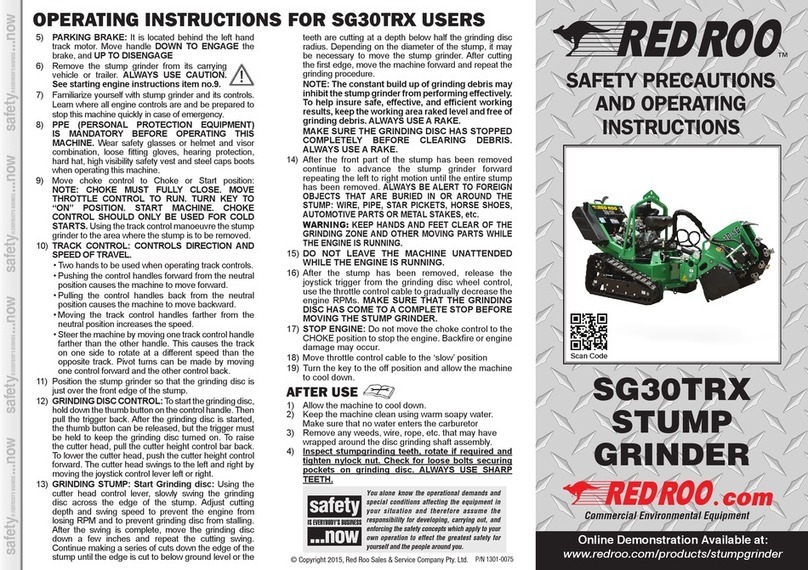
red roo
red roo SG30TRX Safety precautions and operating instructions
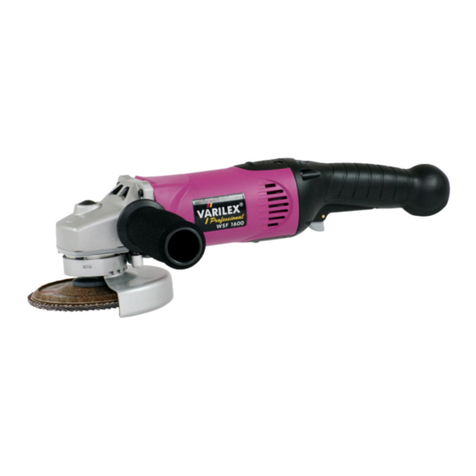
eisenblatter
eisenblatter VARILEX WSF 1600 operating instructions

EINHELL
EINHELL E-WS 125/950 operating instructions
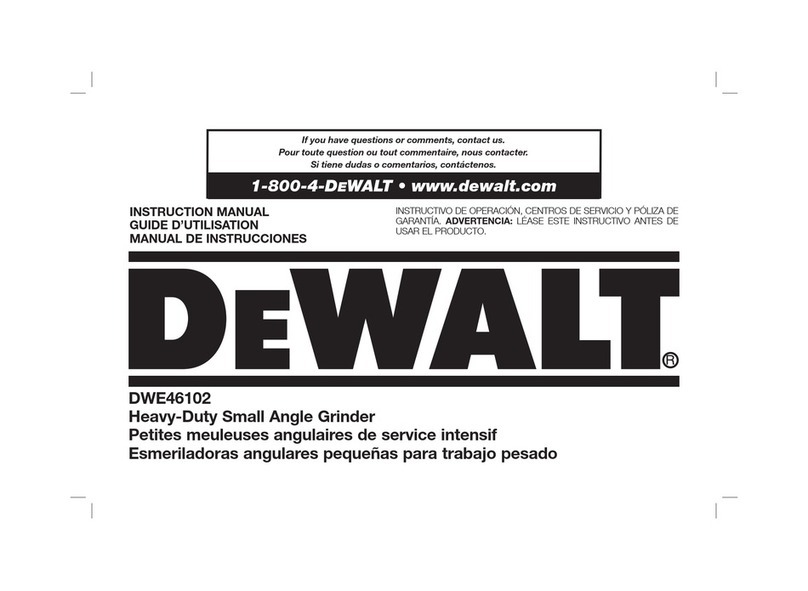
DeWalt
DeWalt DWE46102 instruction manual
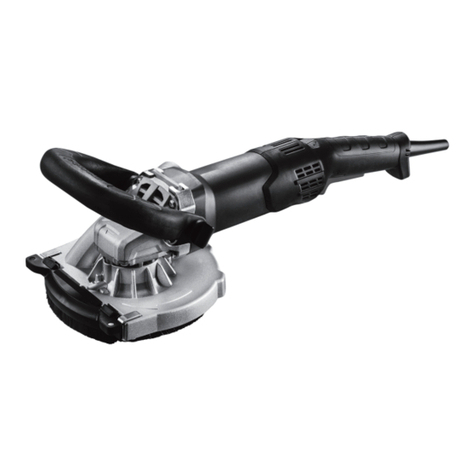
HIKOKI
HIKOKI GM 13Y Handling instructions

Black & Decker
Black & Decker KG900 manual

Baileigh Industrial
Baileigh Industrial BG-248-2 Operator's manual
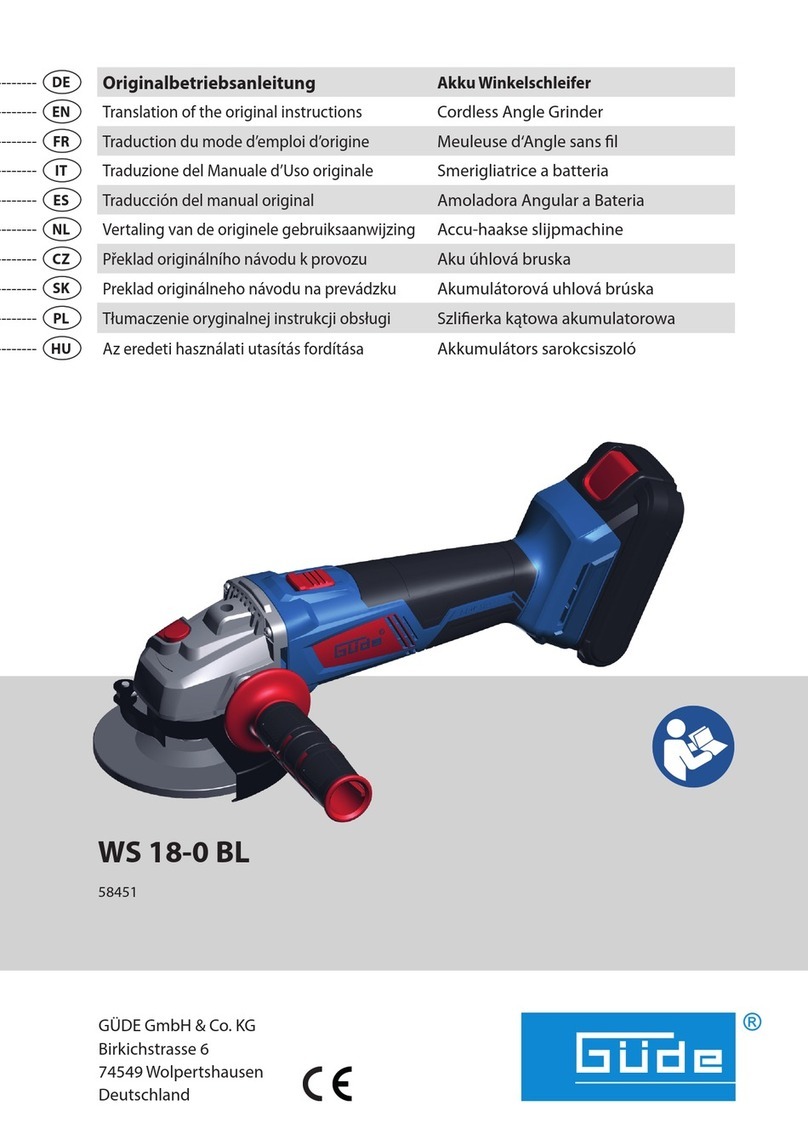
GÜDE
GÜDE WS 18-0 BL Translation of the original instructions
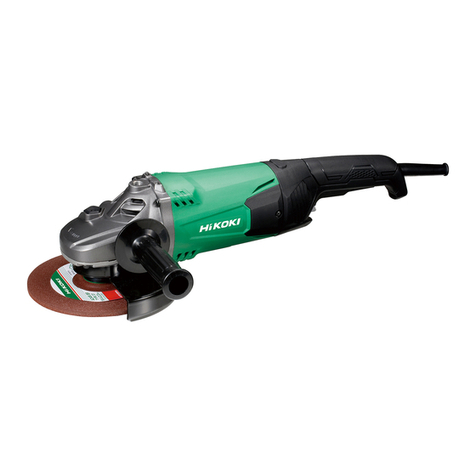
HIKOKI
HIKOKI G 18ST Handling instructions
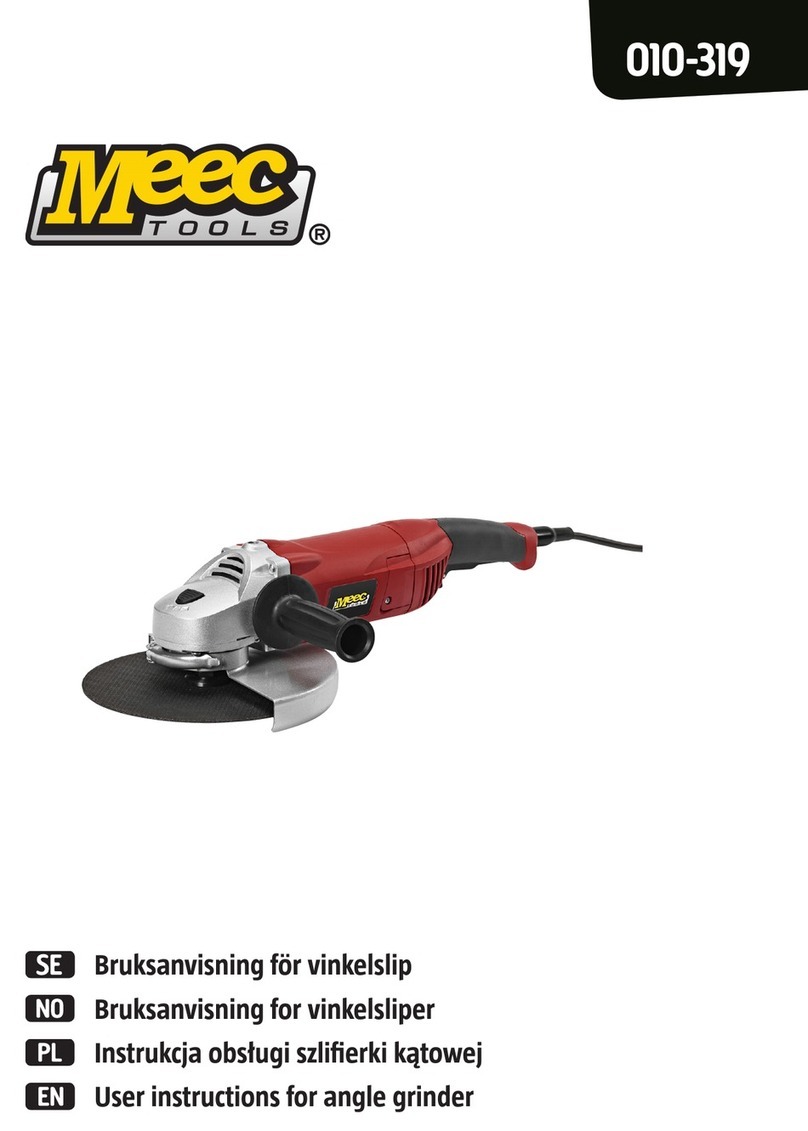
Meec tools
Meec tools 010-319 User instructions
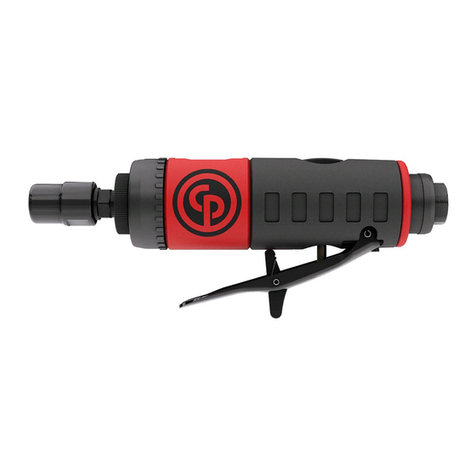
Chicago Pneumatic
Chicago Pneumatic CP7405 Operator's manual

HIKOKI
HIKOKI G 12STA(S) Handling instructions





